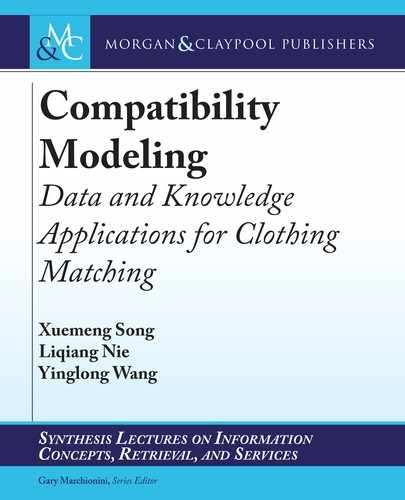
5.4. EXPERIMENT 55
5.4 EXPERIMENT
To validate the effectiveness of the proposed model, we conducted extensive experiments on the
real-world Dataset I by answering the following questions.
• Does our PAICM outperform the state-of-the-art methods?
• What is the effect of NMF in the prototype-guided attribute manipulation?
• How does the proposed PAICM perform in the complementary fashion item retrieval?
We first give the experiment settings and then present experiment results with detailed
analyses on each above research question.
5.4.1 EXPERIMENT SETTINGS
Auxiliary Dataset. To evaluate our PAICM, apart from the Dataset I, we utilized an auxiliary
benchmark dataset of DeepFashion [81] to train the attribute classification networks and ob-
tain the semantic attribute representations of fashion items. is benchmark comprises 33,881
fashion items, each of which is labeled by 18 attributes with 303 attribute elements. Table 5.1
shows several attribute examples and the corresponding attribute elements. Due to the uneven
distribution of the data, we implemented the data augmentation for certain attribute classes with
limited samples by multiple operations (e.g., copy, rotation and shift) with an integrated tool of
Keras.
Table 5.1: Examples of attributes and the corresponding attribute elements
Attribute Attribute Element
Type of trousers Harem pants, straight pants
Length of trousers ree-quarter pants, pirate shorts
Type of clothes buttons Single- breasted, one button
Fitness of clothes Rectangle-shaped, hourglass-shaped
Length of dresses Below knee, above knee
Type of dresses A-line dress, pouf dress
Style of clothes Forest living style, boyfriend-style
Texture of clothes Contrast color, hollow
Attribute Representation Learning. Regarding the semantic attribute representation
learning, we adopted the architecture similar to AlexNet [62] that consists of five convolutional
layers followed by three fully connected layers. We randomly divided the auxiliary dataset into
two chunks: training set (80%) and testing set (20%), and chose the widely used cross-entropy

56 5. PROTOTYPE-WISE INTERPRETABLE COMPATIBILITY MODELING
loss to train all the networks. We adopted the area under the ROC curve (AUC) [4] to evaluate
the performance of the attribute representation learning. To gain more detailed insights, we fur-
ther categorized fashion items in DeepFashion into the three groups: tops, trousers, and dresses
(skirts). Table 5.2 details the classification result of each attribute, where the last row “Total”
refers to the average AUC weighted by the number of attribute elements. As can be seen, the
overall performance of attribute classification with respect to AUC is satisfactory. Due to the
fact that the auxiliary dataset lacks the annotations for the color attribute, for each fashion item
in Dataset I, we extracted the color attribute based on the histogram calculation in the HSV
space and encoded it to an one-hot vector as the color representation of the fashion item.
Table 5.2: Performance of the attribute classification in terms of AUC
Attribute Tops Trousers Dresses (Skirts)
Length of upper-body clothes 0.7606 - -
- -
- -
- -
- -
- -
Type of trousers - 0.7233 -
Part details of clothes 0.8462 0.8697 0.8181
Type of clothes buttons 0.6742
Length of trousers - 0.7707 -
Style of clothes 0.7698 0.7575 0.8325
Fabric of clothes 0.8117 0.8738 0.8241
Type of waistlines - 0.8171 0.7798
Texture of clothes 0.7668 0.8170 0.7387
Graphic elements of clothes 0.7433 0.8166 0.7741
Length of dresses - - 0.8243
Design of dresses - - 0.8446
Length of sleeves 0.7975
Fitness of clothes 0.7135
Type of collars 0.7839
Type of dresses - - 0.7694
ickness of clothes 0.7668 0.8126 -
Type of sleeves 0.7219
Total results 0.7873 0.8280 0.8083
Parameter Tuning. We divided the positive pair set S into two parts: the training set
S
train
(80%) and testing set S
test
(20%). For each positive pair .t
i
; b
j
/, we randomly sampled
three bottoms b
k
’s (b
k
… B
C
i
), and each b
k
corresponds to a triplet .i; j; k/. We adopted the
..................Content has been hidden....................
You can't read the all page of ebook, please click here login for view all page.
